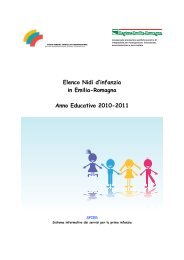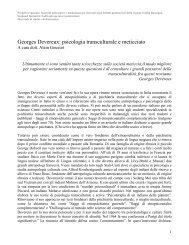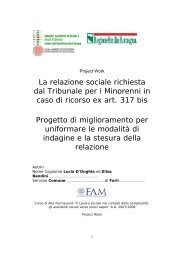Introduzione alla traduzione italiana dei Libri Bianchi dei Casey ...
Introduzione alla traduzione italiana dei Libri Bianchi dei Casey ...
Introduzione alla traduzione italiana dei Libri Bianchi dei Casey ...
You also want an ePaper? Increase the reach of your titles
YUMPU automatically turns print PDFs into web optimized ePapers that Google loves.
In the United States, the practice of ‘permanency<br />
planning’ for children in out-of-home care<br />
emerged in the late 1960’s in response to concern<br />
about the thousands of children found to be<br />
“adrift” in the foster care system with no family<br />
to call their own. Since 1980 with passage of the<br />
Adoption Assistance and Child Welfare Act -<br />
PL:96-272, and again re-enforced in the Adoption<br />
and Safe Families Act of 1997 (ASFA),<br />
permanency planning has served as the broad<br />
casework and legal practice umbrella for the<br />
provision of the continuum of child welfare<br />
services.<br />
For close to 30 years, federal and state legislation<br />
has been passed to support the permanency needs<br />
of children and youth at risk of/placed in foster<br />
care. Complex systems of federal and state funding<br />
have been developed to support and preserve<br />
families, protect children, support out-of-home<br />
placements when needed, and promote<br />
reunification, adoption or legal guardianship<br />
permanency options. Across the country, states<br />
and tribes continue working to revise their policies<br />
and practices to better serve children and families,<br />
while striving to comply with complex legislative<br />
mandates aimed at improving safety, permanency<br />
and well-being of children involved in the child<br />
welfare system. Increasingly states, courts and<br />
community partners have found it beneficial, to<br />
work more collaboratively to address many<br />
challenges to providing quality foster care, timely<br />
permanency planning services, and comprehensive<br />
post-adoption services – for they are learning that<br />
more can be done together than any one entity can<br />
do alone.<br />
dell’identità e sul benessere emotivo del<br />
bambino. 2<br />
To accomplish these goals, child welfare agencies Con lo scopo di raggiungere questi obiettivi, agli<br />
32<br />
Negli Stati Uniti, la pratica della “pianificazione<br />
della permanenza”, per i bambini sotto tutela<br />
affidataria extra-domiciliare, emerse verso la fine<br />
degli anni sessanta in risposta <strong>alla</strong> preoccupazione<br />
per le migliaia di bambini che risultavano “essere<br />
<strong>alla</strong> deriva”, nel sistema di assistenza ai minori e<br />
senza una propria famiglia di appartenenza. Con<br />
l’Adoption Assistance and Child Welfare Act –<br />
PL:96-272, e con il rafforzamento offerto<br />
dall’Adoption and Safe Families Act of 1997<br />
(ASFA), dal 1980 la pianificazione della<br />
permanenza funge da “copertura” di vasto respiro<br />
nell’ambito <strong>dei</strong> servizi sociali e della pratica legale<br />
per fornire il continuum <strong>dei</strong> servizi di assistenza ai<br />
minori.<br />
Per quasi trent’anni sono state varate leggi statali e<br />
federali a supporto <strong>dei</strong> bisogni relativi <strong>alla</strong><br />
permanenza <strong>dei</strong> bambini e <strong>dei</strong> giovani collocati, o a<br />
rischio di essere collocati, sotto tutela affidataria.<br />
Sistemi complessi di finanziamento federale e<br />
statale sono stati sviluppati per supportare e<br />
preservare le famiglie, proteggere i bambini e<br />
sostenere i collocamenti extra-domiciliari, quando<br />
sono necessari, e per promuovere le varie<br />
possibilità per la permanenza: come la<br />
riunificazione, l’adozione o la tutela legale. In tutta<br />
la nazione, gli stati e le tribù degli Indiani<br />
d’America continuano il lavoro di revisione delle<br />
politiche e delle pratiche per poter servire meglio i<br />
bambini e le famiglie, mentre cercano di<br />
conformarsi ai complessi obblighi legislativi messi<br />
in atto per migliorare la sicurezza, la permanenza e<br />
il benessere <strong>dei</strong> bambini che si trovano coinvolti<br />
nel sistema di assistenza ai minori. Sempre più, gli<br />
stati, i tribunali e i partner nel territorio riscontrano<br />
che, lavorare con una maggiore collaborazione, sia<br />
utile per rispondere a molte delle difficoltà insite<br />
nella fornitura di servizi di qualità nell’ambito della<br />
tutela affidataria, di servizi tempestivi nell’ambito<br />
della pianificazione della permanenza e di servizi<br />
post-adozione globali – man mano che si<br />
comprende che insieme si può fare di più di quello<br />
che qualsiasi singolo ente può fare da solo.


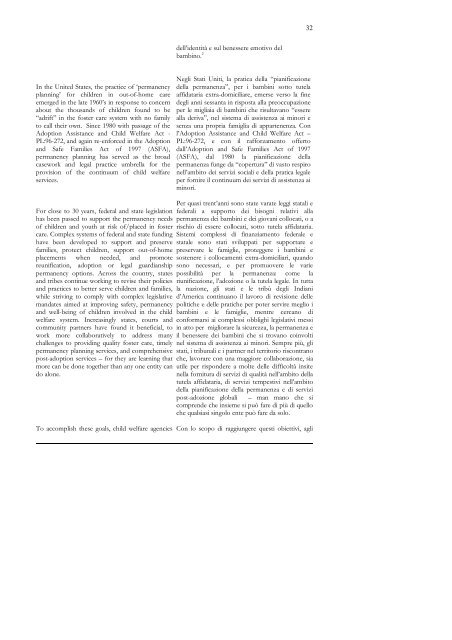
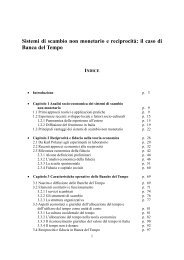

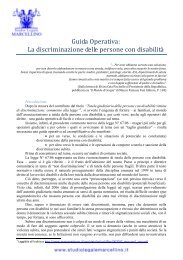


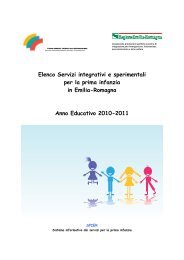


![[PDF] Atti del convegno - Regione Emilia-Romagna](https://img.yumpu.com/15640875/1/185x260/pdf-atti-del-convegno-regione-emilia-romagna.jpg?quality=85)
